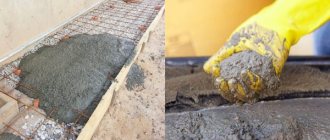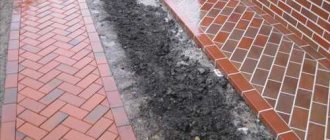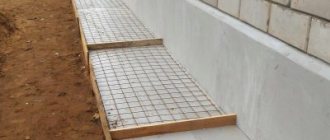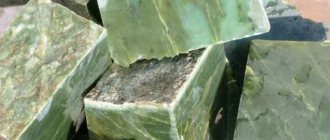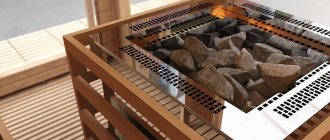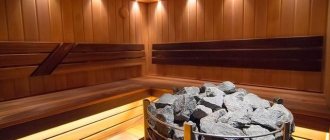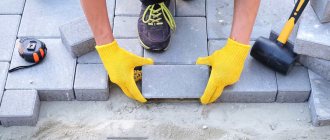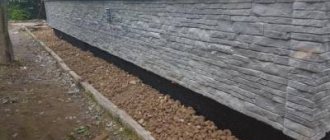Natural stone is mounted on a specially prepared construction site. It goes well with different landscape options, so it is a popular method of creating a unique design.
For many centuries, natural stone has served as a most valuable decorative element that can visually unite separate home objects into a single whole.
We will tell you further how to make a blind area from natural stone (sandstone, flagstone, granite) with your own hands.
For what purposes is it used?
Stone has long been particularly popular in construction and finishing works due to its durability, reliability, structural and color diversity.
During production, this material acquires the necessary surface texture: polished and ground, chipped and filmed, as well as heat-treated, which greatly increases its scope of application. This material is used for rigid, bulk and multi-layer blind areas.
Problems solved by facing a blind area using natural stone:
creating a representative appearance;- construction of a monolithic structure without voids and defects;
- long period of use, capable of maintaining its original consumer qualities for at least 300 years;
- use of environmentally friendly building materials;
- durable building structure;
- invulnerability to natural precipitation, temperature changes and UV radiation.
Types of material with photos
Many types of natural finishing material are available in the trading network today , which are extracted from solid massive rocks for the blind area:
- basaltic,
- marble,
- limestone,
- granite.
First of all, they must have hardness and strength, and not have weathered zones, various cracks and other defects that cause a decrease in strength and durability.
All of them have a high price, so they are most common for finishing:
- flagstone,
- sandstone,
- granite.
Flagstone
Flagstone refers to shale rocks or limestone, which during the mining process can spontaneously split into tiles of various sizes. Such flat tile elements do not require processing.
The material has an excellent appearance with a variety of shades, and has many other advantages that make it especially in demand among individual developers:
- Non-slip surface of the plates.
- Safe, environmentally friendly material that does not have radioactive contamination.
- Frost-resistant.
- With low moisture absorption.
- Quite durable building material.
- Long-term color fastness.
- Easy to process and install.
Flagstone can be freely purchased at a hardware store; in areas where it naturally comes to the surface, you can collect it yourself, selecting slabs of the required size.
Sandstone
Sandstone is also a natural stone, as it is created by nature. Most of it consists of compressed sand , which is why it got its name. It may also include small shells, organic chemical compounds and clay.
Depending on the place where sandstone is mined and the processing method, it acquires different colors: from gray to tiger colors.
The advantages of using sandstone for cladding include:
- high moisture resistance;
- high-strength building material;
- has a layered structure, which makes it possible to create interesting design projects;
- has insignificant weight, which forms the least load on the blind area;
- impeccable in terms of heat and sound insulation qualities, due to its layered structure;
- not afraid of precipitation and erosion processes;
- strongly pronounced rough surface, which creates an anti-slip effect in icy conditions;
- has a relatively low purchase price;
- well presented in prices, colors and sizes in the retail chain.
Compared to granite, sandstone does not have such strength and, therefore, is short-lived, so it is not recommended for use for cargo transport areas.
Granite
Granite stone has historically been considered the best finishing material for blind areas. Its classic geometric configuration allows the use of various paving options, combining strict patterns with fancy ones on the surface.
In such construction finishing, 3 types of granite stone obtained from quarries are used:
- chopped,
- sawn-split,
- clean sawn.
The extensive use of granite in the construction of blind areas is, first of all, determined by the highest technological properties of this building material:
- Strength is at least 2700 kg/m3, which is second only to diamond in this indicator.
- Durability, ability to work without loss of quality for more than 300 years.
- Thermal and frost resistance, capable of withstanding approximately 300 freezing/unfreezing cycles without loss of consumer characteristics.
- Waterproof.
- Environmental safety, does not emit substances hazardous to human health, and the radioactive background of the material does not exceed the natural level.
- Excellent compatibility with other types of finishing stone on the base and walls.
- Large selection of textures.
- Easy to process.
- Extensive color range.
The only disadvantage of granite is its price, but given its long service life, such an investment is considered justified.
Installation
Of all the finishing materials used to decorate the facade of a house, natural stone is the most durable and durable. It gives each building a unique, original look.
Also, for finishing the facade, artificial stone is used with color matching to natural. It allows you to produce products of various shapes and realize almost any architectural fantasy. At the same time, a facade made of natural stone undoubtedly wins in aesthetics, environmental friendliness and durability.
Advantages of finishing the facade with natural stone
Facade cladding with natural stone can be made in various design solutions. A rich assortment of natural stone for the facade and interior allows you to choose the best option for finishing the facade of a country house in terms of quality and price.
Finishing the facade with natural stone increases the degree of heat and sound insulation of the building. In turn, the stone used for finishing the facade has a positive effect on the market value of the building. Decorating a house with Dagestan stone becomes fire resistant. They do not harbor termites, mold and other harmful microorganisms.
Facades made of Dagestan stone. Carrying out installation work from
carries out all types of work on cladding facades made of natural stone. We offer our clients turnkey stone finishing works. Finishing a cottage with stone on a turnkey basis means full support by specialists at all stages of the work.
Clients are provided with assistance in drawing up design documentation, selecting and purchasing facing stone for the facade. Delivery of stone to the work site is also carried out by company employees.
Installation work on cladding the facade of a private house with natural stone is carried out by qualified specialists
The quality of work is controlled at every stage of its implementation. When drawing up a design project for finishing the facade of a house with natural stone, all the features of the structure are taken into account.
Our specialists will offer you the best option based on your wishes and your financial capabilities. In our company, all work on cladding the facade of a house with natural stone is carried out at a high quality level and in a timely manner.
Technology of work execution
Before installation begins, the surface of the façade walls is prepared. We cover walls with natural stone, built from any materials. This can be brickwork, concrete panel or wooden and aerated concrete walls.
During the preparation of the working surface, it is marked and suitable fasteners are selected. Installation of facades with natural stone is carried out in compliance with joint width standards. In this case, high-quality grout is used.
When drawing up a design project and selecting materials, the climatic conditions in which the building is operated are taken into account. Our experts will recommend the best option for natural stone cladding, which will have a long service life.
What are we doing?
LLC "Gallery of Stone" cladding the facade with natural stone, as well as steps, window sills, countertops, and cornices. The cost will depend on the scope of work and the type of facing stone. We carry out turnkey work on any products made of natural and artificial stone. We also carry out paving work with granite tiles and paving stones on the street, and work on laying marble mosaics for indoor floors.
By contacting Stone Gallery LLC, you will receive the best results from our stone cladding services at an affordable price.
Material requirements for construction
Before purchasing a stone for a blind area, you need to pay attention to its dimensions, which are established by the construction project and must comply with regulatory requirements:
- the smallest thickness of stones for main pedestrian paths is 80 mm;
- the smallest thickness of stones for secondary footpaths is 60 mm;
- the smallest thickness of stones for transport infrastructure is 100 mm;
- You cannot use stones that differ in size from each other by more than 2 times;
- when choosing a stone, in order to reduce the number of sawn joints, provide a coating width that is a multiple of 1 m;
- using standard sizes, which will simplify the replacement of damaged slabs in the future;
- If possible, choose standard shape sizes from quadrangles to six or octagons, which will minimize the length of the seams in the blind area.
Correct pie diagram
The choice of stone laying technology directly depends on the type of soil and groundwater level in the construction area. If in some cases it is enough to build a blind area on a sand cushion with stone reinforcement, then in others it is necessary to follow a complex technological cycle.
A professional pie for a concrete blind area made of granite stone should consist of the following layers:
- Priming.
- Clay.
- Waterproofing
- Pressure bar.
- Sand pillow.
- Geotextiles.
- Crushed stone.
- Sand or reinforced concrete.
- Stone.
Why do you need a blind area
The blind area is a covering located around the entire perimeter of the building. Its main purpose is to protect the building and basement from water. It is constructed from waterproof materials, and always with a slope from the foundation.
The main functions that the blind area should perform are:
- protecting the foundation of the house from moisture. For this purpose, a water barrier is constructed from waterproof materials. With its help, melt and rainwater are diverted from the foundation in the opposite direction;
- increasing the thermal insulation of the building;
- comfort during operation of the house. If there is a concrete or stone path around the building, you can place a cozy seating area under the walls of the house or place a terrace;
- aesthetics. A beautiful blind area made of wood, tiles or concrete will give the building a neat and finished appearance;
- preventing damage to the foundation from frost heaving of the soil.
What will you need?
The set of devices and tools for stone paving depends on the type of structure. Most likely the master will need:
- a rod up to 2 m long, for detecting defects on the visible part and for monitoring the quality of the coated surface;
- tape measure/meter for measuring distances and making markings;
- square for checking the compliance of angles;
- building level, plumb line and cords for placing beacons and markings;
- fasteners for waterproofing and formwork;
- mortar container;
- paint brushes;
- steel and rubber hammer;
- Master OK;
- electric drill with sets of special drills;
- cutting machine for trimming elements.
How to calculate the required amount of raw materials?
In order to calculate the stone that is needed for laying the blind area, you must have the following data :
- perimeter and width of the structure,
- as well as the size of the stone,
- thickness of masonry joints and border size.
An example of calculating Kapustinsky crushed stone for the blind area of a residential building with a plan of 10*10 m, where:
- perimeter of the blind area 10x2+10x2=40 m;
- width, 1m;
- total paving area, 1mx40m=40m2;
- tile dimensions, 100x100x50 mm;
- area of one tile, 0.01 m2;
- number of tiles per 1m2.1:0.01= 100 pcs.
- cost of tiles 1 m2, 1530 rub./m2.
- cost of work, 1400.0 rub./m2.
Total cost of facing the blind area with stone: 1530x40+1400x40= 61200+ 56000= 117200 rub.
Preparing the foundation for work
The most popular blind area method is the option of paving slabs. Let's figure out how to lay such tiles with your own hands, without the help of a professional.
In order for your o, it needs to be limited with the help of borders
Work should begin with preparing the soil. To do this, we will use a shovel and remove all the necessary weeds and turf so that they do not interfere with the quality of the installation.
Next, we dig out the ground to the depth of the paving slabs, as well as another 10 additional centimeters. This is done in order to lay crushed stone as a solid base, which is especially important for the area around the garage.
To ensure proper outflow of water, you need to create a base slope so that water can easily flow from the center of the blind area to the edges, in two directions.
The next job is to lay paving slabs. If you have a very large area for which you are creating a blind area, then you need to carefully calculate the plan of action and the number of tiles needed.
If your area is small, then you can safely get to work. To begin with, it is recommended to fill the area that you have prepared with sand to a depth of 5 centimeters.
It is necessary to use lumber in order to compact the base and provide a reliable base for the future paving slab. Next, paving slabs with wooden blocks are laid, which are mounted between the slabs of the paving area.
DIY finishing instructions
Laying a blind area with natural stone can be done on your own without inviting specialists. For almost all types of stones, the following steps are required:
- Design and calculation of necessary materials.
- Purchasing stone and preparing tools.
- Excavation and construction work.
- Fixing curbs and laying tiles with a slope from 1 to 10%.
Flagstone
The process of laying flagstone on a blind area is simple. It requires a marking scheme according to which pegs with cords are installed.
Step-by-step process of lining the blind area with flagstone:
Prepare a trench around the perimeter with a depth that corresponds to the selected construction pie of the blind area from 200 to 600 mm; when installing curbs, 50 mm is added to it.- Spray the base with water and compact it to reduce the risk of soil subsidence.
- Geotextiles are placed to distribute the load.
- Make a 150 mm layer of gravel with tamping and checking the level with a level.
- Geotextiles are laid to prevent mixing of subsequent layers.
- Pour the cement-sand mixture and level it with the rule.
- Flagstone is laid, loading into the top layer.
- The seams are carefully tamped with the dry mixture.
- Sweep away the excess mixture and carefully moisten the resulting blind area with water to prevent the cement from being washed out of the joints.
- Cover with film so that the cement hardens uniformly and
- eliminate mechanical loads on the structure for a week.
Sandstone
Before laying sandstone, the stone must be cleaned. The blind area can be installed in 2 ways - dry and wet.
In the first option, a dry mixture is poured onto the crushed stone in a sand: cement ratio of 3:1 . Next, sandstone is laid, the process begins from the edges, large tiles are installed. The slabs are slightly sunk into the dry mixture, the seams are filled with a similar mixture and spilled with water.
With the traditional wet installation method, this mixture is diluted with water with the addition of Ceresit 85 glue. For ease of installation, the stone is first laid out in width and length equal to the wall of the house in order to select elements according to size and color preference.
After laying out the stone, remove several units and lay out a solution up to 20 mm thick in the free space. Return the tiles to their place, press them tightly, pressing them into the liquid mixture. After installing the stone, the seams are rubbed with the mixture.
Laying sandstone in a blind area, video instructions:
Granite
Granite paving can be done on a concrete base, sand cushion and on a reinforcing concrete layer. Granite laying technology:
- prepare a trench;
- water the soil with water and compact it;
- lay out geotextiles, crushed stone and 5 cm of the mixture, which is compacted;
- the next layer is laid every other day, with a greater thickness than the first;
- Granite stones are laid on it, pressed down and tapped with a rubber hammer, and the seams are sealed with mortar.
Minor damage repair technology
The technological process for sealing small cracks and chips consists of the following steps:
- cleaning the surface of the protective line in the area of the depression or chip;
- shallow cracks are treated with two layers of a deeply penetrating primer solution;
- Defects are sealed using cement-sand mortar in a ratio of 1:2. A spatula is used for this work. Half an hour after filling the cracks, the sealing area must be rubbed with a wooden trowel and dry cement;
- defects such as peeling are eliminated by cleaning and filling the areas with bitumen mastic, asbestos and slag. It is recommended to use the composition in the following proportions: 75% - mastic, 15% - asbestos, 10% - crushed slag. After sealing, pour a layer of sand onto the surface.
Possible mistakes
Natural stone is heavy, so the main mistakes that developers make occur when choosing a blind area and violating the design dimensions: width, depth and slope. Therefore, the structure does not fulfill its protective functions.
The most common mistakes when making a cake are a violation of the process of compacting layers and the absence of a waterproofing layer, which leads to the destruction of such a blind area already in the first year of operation.
Masking the seams
Do-it-yourself blind area
After the work done, you need to take care of the seams. They are filled with sand. A more reliable and durable material for filling joints is a cement mixture.
This mixture is prepared from one part of cement and three parts of sand. Using a brush, you need to gradually fill the seams and gaps.
After you have done this work, you should take a hose and water the entire blind area with cold water. This will greatly soften the cement, and the blind area will become even more reliable in the future.
Next, the blind area should dry for two days, without any impact on it.
We would like to note that the blind area is becoming more popular every day, all because it is not difficult to install, is economical in price, looks beautiful, and most importantly, it drains water from the territory of the house into a special storm drain.
Another popular type of blind area is sand blind area. It's easy to do it yourself. The blind area performs not only a protective, but also a decorative function.
Pros and cons of use
Natural stone is a solid material for finishing work on arranging a blind area.
Its most valuable qualities include:
- Large selection on the construction market.
- Easy to install.
- Long service life.
- Heat resistance and moisture resistance.
The disadvantages of stone, many users include its high price, weight and high shipping costs.
Prices in the Russian Federation
Prices for natural stone for blind areas depend on the type, size, location of the quarry and the method of its processing.
For example, for granite stone the price depends on the method of production , the cheapest chipped stone starts from 1050 rubles/m2, and the most expensive is sawn chipped stone from 3200 rubles/m2. The cost of flagstone depends on the appearance, thickness and external dimensions.
The price of large thick slabs starts from 3500 rubles/m2 and thin “MULTICOLOR” slabs from 300 rubles/m2. Burnt red flagstone, with a thickness of 1.5 to 3 mm, costs up to 630 rubles/m2, and stones measuring 100x200 mm - from 1900 rubles/m2
Price of work per m2 of area
The price for making blind areas made of natural stone depends on the chosen finishing material, the size of the paving stones or slabs, as well as the construction area.
Average prices for paving a blind area with stone:
| Type of operation and material | Slab size | Laying type | Price RUB/m2 Moscow | Price RUB/m2 Sochi | Price RUB/m2 Chita |
| Granite stone | 10*10*10 | Straight paving | 1400 | 1230 | 1340 |
| Radial paving | 1600 | 1100 | 1550 | ||
| Segmental paving | 1700 | 1560 | 1680 | ||
| Flagstone | Selection method | 1400 | 1200 | 1350 | |
| By sawing method | 1650 | 1450 | 1700 | ||
| Sandstone | On crushed stone | 1150 | 890 | 1100 | |
| With a crushed stone base | 1450 | 1100 | 1300 |
Important and useful information about materials for the construction and finishing of blind areas around the house is presented in this section.
Side curb stone
Granite side stone separates the roadway from the sidewalk or curbs. Our stone processing production allows us to produce side stone, GP-1 curb - 100 km per year.
- Granite
- Marble
- Paving stones
- Retail
- Price list
- Special offers
- Site Map
Group of companies Vozrozhdenie © Russia, Moscow, st. Burakova, 27. Tel. Selling granite inexpensively * Prices presented on the website are not a public offer
